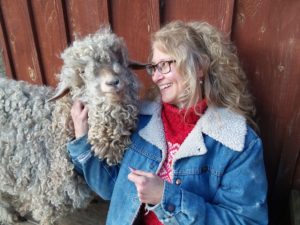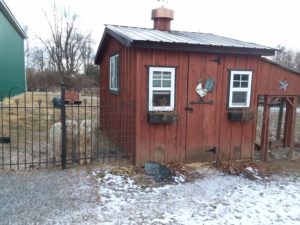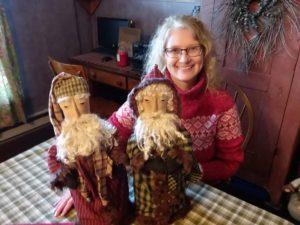Those long, wooly tresses. The calm, wise eyes. And that cuddly disposition — is there a person alive who can resist the allure of an Angora goat?
Not Betsy Guffey, of Mifflinburg, proud owner of two female Angoras named Bobbi and Charlotte.
“If you see pictures of baby goats, oh my God, you fall in love,” Guffey said. “You just fall in love with them.”
A person who appreciates self-sufficiency, Guffey had always wanted to raise alpacas and use their wool in her craftwork.
“I always loved the concept of the sheep-to-shawl,” she said. “You start with an animal, then shear it, spin or weave the fibers, and you’ve got a finished product.”
When her husband, Jesse Guffey, learned five years ago about Angora goats at a farm in Trout Run, the couple decided to give the animals a try. Jesse built a small barn and pasture and became the main caretaker as far as daily feeding and watering, while Betsy learned to card the wool for her crafts and is even learning how to spin it into yarn.
Jesse trims the goats’ hooves every six weeks or so, and the couple keeps a sharp watch on the animals’ eye color. Pale pink indicates a need for medicine. That, along with regular feeding, stable maintenance and shearing keeps the Angoras healthy and happy.
Unfortunately, their first three goats faced a tragic end when Jesse fed them yew branches, not knowing yews are poisonous to Angoras.
“They eat evergreens,” Betsy said. “They love evergreens.”
So when Jesse fed them the yew branches he thought he was giving them a treat, only to learn that yews cause irreparable heart damage in Angora goats. All three died.
“We’re really careful of what we give them now,” Betsy said, adding, “They love maple leaves and ginger snaps.”
Heartbroken and missing their little pets, the Guffeys decided to continue raising Angoras and bought Bobbi and Charlotte from a farm in Maryland. They would love to meet other Angora goat owners to compare notes and trade goat-raising tips.
“We do not breed at all because we really just wanted them for pets,” Betsy said. “They are the friendliest, most awesome animals. Just to come home after a long day at work and hug a goat …” She sighed and smiled.

Efficient fiber producers
Compared to sheep, which are shorn once a year, the goats are sheared twice a year and yield about four pounds of fiber for each animal per shearing. Their fibers, called mohair, are about six inches long and very, very soft.
“Angoras are one of the most efficient fiber-producing animals,” Betsy said, adding that their hair grows about one inch per month.
She washes the fibers with Dawn dish detergent and very hot water to remove oils and dirt then lays the mohair on sheets to dry in the sunshine. Betsy uses most of the wool as stuffing and decorations for Old World Santas and Waldorf dolls.
“Waldorf dolls use all-natural fibers,” Betsy said. “Mohair is naturally self-cleaning and also warm and soft, so it’s great to stuff dolls with that.”
The simple, huggable Waldorf dolls are made with neutral expressions to encourage a child’s creativity. Betsy makes clothes and knits tiny sweaters and shoes for them. She also saves the twisted ringlets at the ends of the Angora wool to use as curly beards and eyebrows for the Santas and wavy hair for the dolls.
“It’s just so soft,” Betsy said of mohair. “It’s just the best fiber out there.”

Routine care
Dagny Leininger, DVM, with the West Branch Mobile Veterinary Clinic, Lewisburg, noted that goats not raised for agricultural production can live 12 to 13 years. From a medical standpoint, their two biggest issues are parasites and urinary stones.
Preventive healthcare for goats consists of vaccinations and routine fecal exams to watch for intestinal parasites, Leininger said. She cautioned that caring for a goat requires maintenance similar to that required for a horse.
As for a goat’s reputation of being somewhat naughty and stubborn, she remarked that each goat is different.
“It depends on the goat,” Leininger said. “Just like with people or dogs, there’s a variety of personalities.”
“They just want to be around people,” Betsy said of her Angoras. “They love people, and they’re so very gentle. They’re like a dog, only better.”

What is a Waldorf doll?
Ever hear of a Waldorf doll? Betsy Guffey, Mifflinburg, has started making the simple doll because its qualities — natural materials, plain face, cuddly body — mesh nicely with her interests in self-sustainable practices and reducing waste.
“I was always interested in the old, traditional trades,” Guffey said. “I would love to be more self-sufficient and more self-sustaining. If we didn’t just throw out the old all the time, (but) try to reuse it.”
Guffey uses the mohair she shears from her two Angora goats as a soft, warm stuffing for her Waldorf dolls.
“Waldorf dolls use all-natural fibers,” Betsy said. “Mohair is naturally self-cleaning and also warm and soft, so it’s great to stuff dolls with that.”
“Waldorf education was developed in school in Waldorf near Stuttgart in Germany (started in 1919),” according to historyofdolls.com. It was one of the key principles of Rudolf Steiner, “the founder of anthroposophy, who insisted on various stages of child development.”
Stressing the importance of sensory stimulation, Steiner found the Waldorf dolls appealing because their neutral faces allow a child to imagine many expressions, and the doll’s soft, wool stuffing absorbs the child’s warmth.
These same qualities endear Waldorf dolls to children today.
